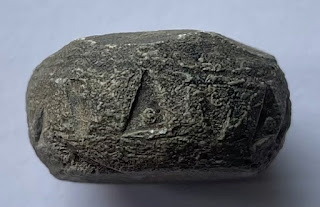Viking lead weights, inset with metalwork, coins, glass, enamel, and other materials, were used by Viking tradesman/warriors associated with the Great Heathen Army in England in the mid to late ninth century. Indeed, both weights and deliberately cut metalwork and coin fragments are part of the archaeological ‘footprint’ of Viking camps such as Torksey in Lincolnshire and Aldwark in Yorkshire. The weights were likely used for weighing silver in bullion transactions and, potentially, for weighing metals in manufacturing contexts. In being capped with metalwork, often Anglo-Saxon, Irish or Carolingian in origin, they are distinct from a larger and plainer group of Viking lead weights with no such decoration. How and by whom were they produced?
 |
Given that the association of the weights with Viking camp sites is strong, we suggest that silversmiths or other small-scale metal workers within camps were responsible for the weights’ manufacture. Such individuals would have had the technical skill to melt and cast lead, and to cut metalwork to the right shape, alongside access to lead metal and stores of metalwork that could be cut up and used as decoration. Whether such people were original members of the military force of the Viking army, who were also craftspeople, or part of the community that supported the various requirements of the camp is an open question. But camps would have been an ideal location to ‘set up shop’ and sell or trade with the many warriors and tradesmen with who the smiths were cohabitating with during the long winter months.
While many items inset into the weights were in contemporary circulation in Britain and Ireland, and would thus have been ‘available’ to invading groups, the inset items can be much older, sometimes by hundreds of years, than the weights themselves. Curious sixth-century fragments of Anglo-Saxon brooches, earlier Anglo-Saxon coins that had long since ceased to function as currency, and even bronze Roman coins have been found inset into the Viking weights. The probability of a ‘professional’ silver/metal worker having access to these objects through trade networks seems much more likely than that of a warrior/tradesman seeking fame and fortune being concerned with collecting such things.
The weight on the right is inset with a fragment of a sixth-century Anglo-Saxon square-headed brooch (below). Copyright Gary Johnson.
The fragment would have been hundreds of years old when re-used in this way. One interesting weight suggests a potential link between silversmithing and weight manufacture. It has triangular punchmark designs around the circumference of the lead that strongly resemble those used on Viking silver bracelets and other silver items. Notably, such punches are similar to those that appear on a lead trial sheet from the camp at Torksey. The weight is embedded with a silver sceat (small, dumpy silver coin) minted in Kent in the very early eighth century – a coin unlikely to have been in circulation in the later ninth century. Was the coin part of the stock-and-trade of a craftsperson, to be recycled or melted down for its metal.
A lead weight, with alternating triangular punchmarks with central pellets (below), inset with a sceat, minted Kent in the early eighth century. Photo copyright Gary Johnson
This interpretation has important implications for how archaeologists view lead weights. It has been argued that the metalwork on the weights represent the spoils of raids – Insular metalwork of high artistic but low economic value, that was symbolic of the success of Viking raids. Certainly, such weights are found in sets, and in graves of individuals, so seem to have been markers of status. However, in our interpretation, the owner of the weights would have commissioned the weights to be made, and was selecting the inset metalwork from the various items of bronze or other materials (old strap ends, bronze stycas, pieces of glass or enamel etc) carried by the metalsmith.
Perhaps metal smiths had a ‘side business’ at the overwintering camps providing either ready-made trade weights or taking custom orders for more personal pieces. Inset weights range from lead embedded with simple metal pellets or studs to those with elaborate pieces of exotic and visually pleasing insets of gilt bronze, enamel, silver, coins, and glass. A style for every taste and budget, as we would say today. The winter camps were also an ideal location for the enterprising weight manufacturer, as a camp tent providing this service would have a ‘captive audience’ of eager and optimistic warrior/tradesmen with silver to trade over an inactive winter.



No comments:
Post a Comment